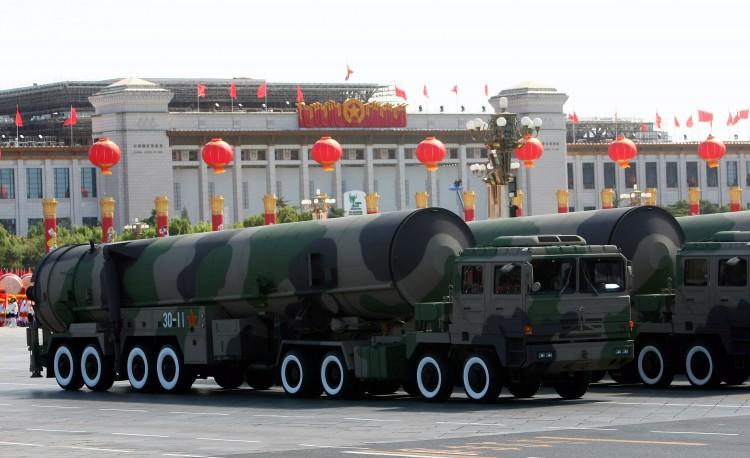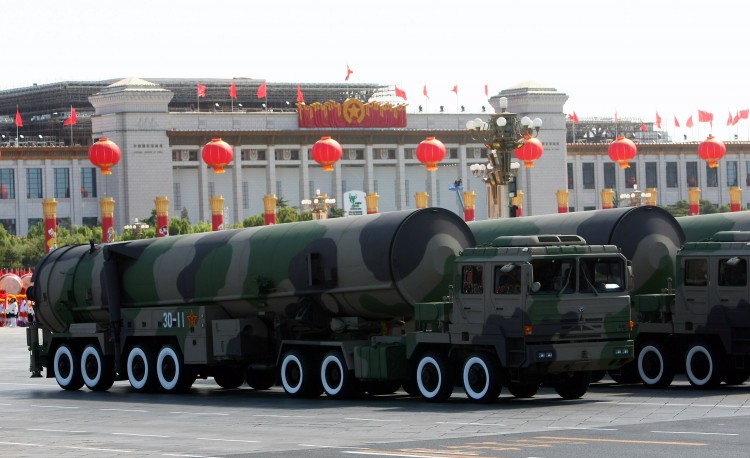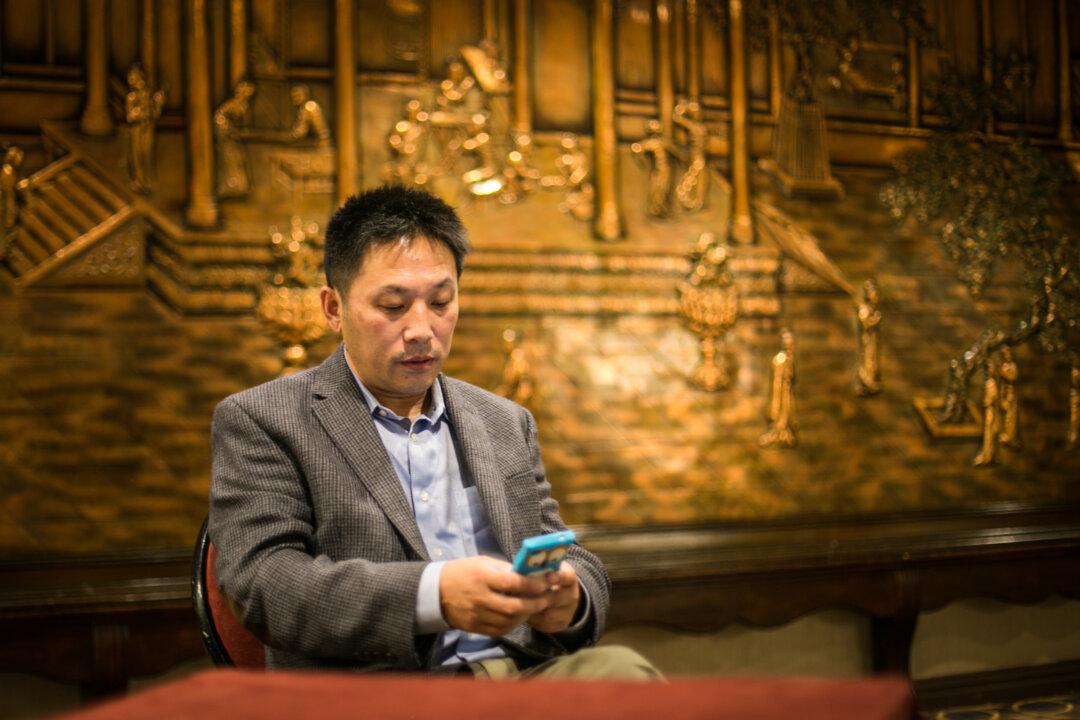WASHINGTON—A hole in the ground means different things to different people. But what about a complex network of caverns more than 3,000 miles in length, deep underground, wide enough for two or three train cars, and used to keep nuclear weapons?
Prompted by a recent report by a Georgetown University professor, a debate has emerged among academics and arms control policy wonks about what that means, if anything.
At stake, potentially, is the global arms control regime, U.S. strategic planning on China, and stability in Asia.
Phillip Karber, Ph.D., from Georgetown led a group of 20 students in the Asian Arms Control Project who watched hundreds of hours of Chinese military footage, analyzed millions of words of text, and produced a report distilling their key findings.
They document in the forthcoming report (it is being held up for a security review) how the Second Artillery Corps constructs and maintains its tunnel complexes, often in mountainous regions, and how it uses them to conduct nuclear weapons exercises.
The Second Artillery is a crack military squad tasked with keeping custody over the Chinese nuclear arsenal; they answer directly to the Central Military Commission, the Party arm that oversees China’s armed forces.
The report generated immediate controversy, mostly because of the numbers that Karber had presented as possible Chinese nuclear holdings: 3,000, at one stage. These suggestions were immediately and efficiently dismantled by researchers in the arms control community, including Jeffrey Lewis, Hans Kristensen, and Gregory Kulacki, who went to Hong Kong and dug out one of the original sources that Karber had cited citations of. Karber later said that the 3,000 figure was on a timeline to 2020.
Nuclear Strategy Questioned
The dust having settled on that portion of the debate, however, the question remains as to what the meaning of all those tunnels is. And on that point, different analysts say different things.
“It’s a very difficult debate because it’s not about facts, it’s about circumstantial evidence,” said Hans Kristensen, director of the Nuclear Information Project at the Federation of American Scientists. “It’s hard to hold on to any particular part of the debate.”
Some analysts highlight precisely the question of the unknown. “If anything, what Karber has done is cause us to question any definitive conclusion about China’s nuclear weapons sector,” said Richard Fisher, senior fellow in Asian military affairs at the International Assessment and Strategy Center, in a telephone interview.
Others say that there’s nothing new here, and that Karber’s findings simply reinforce the prevailing understanding of China’s nuclear strategy: That is, to field a small number of nuclear weapons, protect them well, and make sure they are available only for a retaliatory strike.
But is so much tunneling needed for just that?
Gregory Kulacki, China project manager at the Union of Concerned Scientists, is convinced that the strategy being adopted is similar to that proposed and later scrapped by the United States in the Cold War for the MX missile.
“I think the tunnels suggest that the primary Chinese concern is about the survivability of the weapons they have. That to me is one of the things that can possibly be explained by these tunnels,” he said in a telephone interview.
Jeffrey Lewis, director of the East Asia Nonproliferation Program at the Monterey Institute, largely shares that interpretation, he indicated in an interview; he wrote a book called “Minimum Means of Reprisal: China’s Search for Security in the Nuclear Age.”
Karber dissents. “It doesn’t make sense to go to the expense of producing 10 times as much tunnel” as necessary, he said on a phone interview. “That is mind boggling.”
The MX theory also doesn’t take into account the vast sizes of the complexes, Karber said. “These things that are 60 feet wide and 50 feet high, you could use two or three trains in that space.”
Arsenal Size
But tunnel space does not equal arsenal size.
Not knowing the precise number of nuclear warheads does not mean that “the sky is the limit,” as Kristensen put it. “We can’t just assume the worst.”
Karber’s assumptions are not rosy. He points to Chinese primary sources, which indicate that the tunnels are primarily used for nuclear weapons, notwithstanding the other possible uses.
But how many nuclear weapons?
Certainly not 3,000, and definitely not 2,350—both ideas that Karber has thrown out there at different stages of presenting his ideas. The problem was that those figures came from dubious sources.
The International Panel on Fissile Materials said, “China maintains great secrecy about its military stockpiles of fissile materials.”
There are agreed-upon figures for how much highly-enriched uranium and plutonium that the Chinese military could have produced, which allows a potential range of between 360 and 1,300 warheads, according to a study by Hui Zhang for the Belfer Center at Harvard University. However, the consensus view is that China has about 240 nuclear warheads.
Karber highlights that it could be the largest figure. He will be content if he can simply mount a credible challenge to the current assumptions, rather than erect a new set.
“What the tunnels do is undermine the credibility of current American estimate about the size of China’s nuclear missile arsenal,” says Fisher, the military analyst. “Of course they don’t give any indication of how large the arsenal actually is today. But at a minimum it causes us to question whether current public U.S. estimates are valid.”
Jeffrey Lewis says that people calling into question claims about weapon numbers need to present counterevidence. No evidence has been made public that there are more than the known components—that is fissile material—needed to actually build the weapons.
Next ... Troubling and Complicating
‘Troubling and Complicating’
But with 3,000 miles of underground caverns, could China hide a reactor?
In April 2010 the regime opened to the public the 816 Nuclear Military Plant, turning a once secret military site into a tourist attraction. It had been built in the 1960s and held an incomplete nuclear reactor 80 meters (262.47 feet) tall. The outside world knew nothing of it until the military went public and made it a tourist site, Karber says. What stops them from doing it again?
It’s possible but unlikely, say analysts, because of the potential external signatures that would give it away.
Military analysts emphasize the ominous potential of the tunnel network; whereas arms control researchers highlight what is currently known. And that is where the debate founders: a 3,000-mile question mark and a series of jousting contentions.
Karber worries. “I see these very, very large tunnels, and they only make sense for road-mobile ICBMs,” he said, using the acronym for intercontinental ballistic missile.
“This is not just a few missiles being put in, or merely business as usual, it is dramatically different,” he said of the tunnels. “They’re bigger, they’re designed for complex loading, they have real-time command and control, they have very advanced humidity [controls], and they’re just much larger,” he said.
Beijing’s infamous opacity clouds the debate. No observer knows for sure how many nuclear weapons the regime may have, and the existence of the tunnels makes it effectively impossible to know for sure.
That lack of certainty brings diplomatic and political ramifications, according to Christopher Ford, director of the Center for Technology and Global Security at the Hudson Institute.
The whole Karber debate simply “reemphasizes the issue of how little we know about the Chinese nuclear strategy.” Making projections based on American expectations as to what is reasonable may not be wise, he indicated in a telephone interview.
Since the Cold War the United States and Russia have been reducing their nuclear stockpiles. The idea that China is ramping up its nuclear efforts—one interpretation of the tunneling—could complicate that process, he said.
“There are any number of issues that are enormously complicated by these sorts of question marks,” Ford said. “It’s troubling and complicating in ways that one might wish one did not have to confront.”







